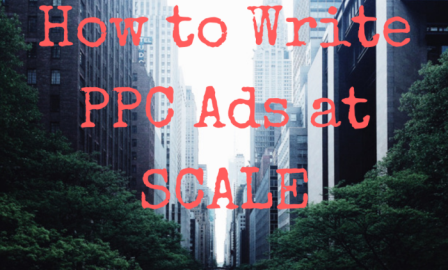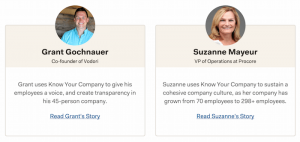You should have at least two to three ad variations per ad group. Which, if you’re doing a decent job keeping keywords tight in each ad group, means you’re supposed to be creating a LOT of ads across all your campaigns.
You should also be A/B testing different hooks or angles with these ads to determine which copy works best.
And if you’ve got a large AdWords account or, worse (if you’re an agency) many large accounts to manage, this all gets even more complicated.
And then there’s the looming specter of Expanded Text Ads – they’re available now, which means you should be getting ahead of the competition. And later this year, the old ad format will be retired completely, so eventually, you absolutely have to update every single one of your ads.
But let’s be honest: that’s probably not happening. Because work. Meetings. Calls. Clients.

The good news, is that it’s not too difficult to get back on track. You just need help – someone or something to come in and help you write ads at scale so you can get back to business.
Here’s a process for doing that without breaking the bank.
Scale PPC Ad Writing by Leaving Creativity at the Door
To scale PPC ad writing, you need to quickly get across the main gist of the message, with a laser-focus on keywords, and some type of differentiator like a benefit or feature which sets you apart. That’s it!
The trouble comes when you (or someone you hire) tries to get creative. You don’t want creative. You want effective.
ADDYs aren’t going to do you any good. With AdWords, you’ve got other stuff to worry about. Namely, purchasing intent, Quality Scores, click-through rate, and cost per conversion.
Research backs this up. Years ago, Made to Stick recounted the following:
“In 1999, an Israeli research team assembled a group of 200 highly regarded ads — ads that were finalists and award winners in the top advertising competitions. They found that 89 percent of the award-winning ads could be classified into six basic categories, or templates.”
“The researchers also tried to classify 200 other ads — from the same publications for the same types of products — that had not received awards – and they were only able to classify 2%.”
This study showed that, contrary to popular belief, the most successful ads of all time were highly “templated” while the most “creative” ads were not as successful.
Believe it or not, this is great news. It means you don’t need to hire an expensive ad agency or copywriter to scale your PPC ad copywriting. In fact, once you’ve got the process in place, almost anyone can do it.
Here’s how to get started.
Step #1. Build Your Foundation for Ad Scaling Success
Most people go straight into a campaign, blindly throwing words together to haphazardly get a few ads online ASAP. Or worse, they hire an employee or contractor straight away, throwing them into the deep end, immediately grading or paying them based on the quantity (not quality) of ads they’re able to churn out.
Obviously, that’s not ideal. Because in many cases, they have no idea who they’re writing for or why those people would care.
The key to scaling PPC ad creation is by getting organized first and systemizing the process prior to any writing.
Like all good promotion campaigns, start with your customers and clients. We’re assuming for the sake of brevity that (1) you already know who they are and (2) you’ve already done some basic research into why the buy.
The very first step is not to start with what you sell, but instead what your customers’ primary obstacles and pain points are – determining why people might need you (and whatever you have to sell) will eventually help you position it properly (like, say, in your PPC ads).
The answers might surprise you. For example, my own research after working with business owners directly for years showed that the leading reasons for failed marketing wasn’t a lack of knowledge, but a lack of (1) process and (2) accountability.

My clients needed me because they had trouble completing tasks.
Once you know the primary obstacle, you can start coming up with the desired outcome or end result. In other words, show people how you will help them overcome obstacles, emphasizing both what they stand to gain and the pain of potential loss.
Then, and only then, would you want to get into what your company does better to deliver this solution. These are examples or stats for your features, benefits, outcomes and end results.
Now put all of this stuff together in a simple spreadsheet or document so everyone working on this account can see it. Here’s an example of what that looks like for a hotel in Central America:

This content messaging overview includes customers’ main pain points, their desired outcomes, as well as the hotel’s key features and benefits (that lead to those desired outcomes).
The next step is to start figuring out the hooks or themes that will align with each customer persona. Different people will be motivated by different things. So the trick is to come up with a few different ideas or options for each that you can test later.
Here’s another example of how that persona-driven messaging might look (using the same company as before):

Now you’ve got a basic foundation to build on.
For more reading on this topic, Digital Marketer has a similar process they use called The Ad Grid that goes into greater depth on building out an advertising framework based on your customer types and potential hooks.

Step #2. Build Your Ad Template Set
Naming conventions are used by programmers or developers to create a standardized way to manage large sets of data. Typically they’re juggling different variables, types, or functions, and naming conventions help provide simple identifiers to keep everything organized.
The benefits include:
- Making it easier to remember, read and understand what they’re looking for
- Creating a set of standard variables during code reviews and quality control
- Improving accuracy of the eventual results
Writing PPC ads should be the same.
If we’re leaving creativity at the door, we should instead have a set system or pattern for the ad creative so that we can attain the same benefits listed above when naming conventions are used.
One of my favorite examples of this starts with the single keyword ad group (SKAG) framework from Johnathan Dane at Klientboost.
The concepts start by isolating high-performing keywords into a single ad group, using each match type for each. Like so:

Ad Group: Marriage Proposal Planners
- Broad: +marriage +proposal +planners>
- Phrase: “marriage proposal planners”
- Exact: [marriage proposal planners]
Reorganizing your campaigns this way is time-consuming. However, it makes ad writing insanely easy going forward.
Alls you gotta do now is create a standard ad format with elements that can be mixed-and-matched depending on the hooks for each persona we discussed in the last step and the right keyphrases (that we’ll find in the next section).
Again, Johnathan lays out an excellent example to start with, recommending you start with keywords in the title and first line and benefit and call to action in the second.
When finished, it could look a little something like this:

Obviously, this is just one example and yours can vary. However starting with a standardized template similar to this (or perhaps a few depending on the scenarios outlined earlier) should already give you a glimpse into how this will soon scale.
Step #3. Keyword-Backed Copy
The next step is to start researching keywords (if you’re starting from scratch or don’t have all of this data to begin with).
The obvious starting point would be AdWords’ own Keyword Planner tool, but it does have some shortcomings. My new favorite tool for starting the keyword research process is the Moz Keyword Explorer. This tool is great for initial brainstorming and helping you build lists of different contextually related topics (while also getting a snapshot of potential competition).
Start by dropping in some potential keywords:

And you’ll quickly get a list of similar phrases to add to your list based on:
- Relevancy (hooray!)
- Volume ranges (that can be used to broadly indicate ‘Head’ vs. ‘Long Tail’, inferring both competition and cost)

However, this tool is designed more for organic search (SEO) as opposed to paid (SEM). So once you have a basic list setup with a good starting list of keywords, you can hop on over to SEMrush to complete the process with more detailed research, or use WordStream’s Free Keyword Grouper to organize those keywords into campaign-ready groups.
In SEMrush, you can drop in some of the initial key phrases and you’ll get more suggested phrases along with sample ad copy from some of the competition (which we’ll dive into later).

Throughout this process, you don’t want to just choose terms like a robot focusing on the most popular ones. The intent behind each term is critical too.
Figuring out the intent of each keyword helps you determine how to sell or frame each. That’s the hook: the compelling way your widget solves/changes/improves keyphrase XYZ. Or:

The Digital Marketer article I mentioned earlier lists out six excellent hooks to start with:
- How does the offering change the user’s life (the before and after effect)?
- How does it make them feel emotionally?
- How (specifically) does it improve their average day?
- How does it affect their status or vanity?
- Is there quantifiable proof of results?
- What’s the expected time to results (i.e. speed)?
Step #4. Create Ad Template Sets
At this point, you’ve got a basic understanding of why people should buy your stuff (instead of the competition’s).
You’ve got a basic understanding of how an ad should “template” out, making it easy to re-write. And you’ve done some initial research into the specific keyphrases to choose and hooks to incorporate.
Now let’s sit down and crank a few out. The easiest way is to start with your basic template and customize based on keyphrase + hook.
Here, I’ll show you. Let’s use an example from my friends The Yes Girls, who help men plan the perfect wedding proposal.
The first ad:

Pretty good! You can see the primary keyword loud-and-clear, and the rest of the ad is pretty direct.
Now let’s try a few variations based on popular hooks that can apply to almost any business.
Zen: You take care of the details so they don’t have to.

Here’s another spin or variation on that same theme. (Note: I wouldn’t necessarily recommend throwing a wedding proposal together at the last minute.)

Mistake: Help people fix mistakes they might be making, or avoid impending doom.

Piggyback: Leverage the credibility of a larger brand, person, or entity.

As you can see, there’s room to deviate from the script so you’re not just hitting Control C, Control V, and changing a single word. But in each case, you’re keeping the same basic structure intact, and simply altering the messaging based on the information you’ve already gathered in previous steps.
Step #5: Add Labor
Congrats, you’ve done (most of) the hard work!
You’ve got a research-backed foundation for:
- What your customers are struggling with
- How they want to solve it
- How your product/service gets them from A to B
You’ve got some potential hooks and angles for each customer type, persona or segment too (to test a few different options). And you know which keywords to target and to plug-and-play in your PPC ads.
Now it’s time to scale.
Adding labor is like adding gasoline to a fire. Add it too early before you get the sparks and kindling working just right and you risk smothering your initial progress. But add it later once everything’s set up and you’ll have a roaring blaze in no time.
Now that your ad creation process is broken into bite-sized chunks, anyone can plug straight into the process (regardless of experience and skill level).
At the early stage, you’re just trying to test a broad mix of keywords, audiences, and hooks. So spray and pray! AdEspresso had an awesome article about using freelancers and Fiverr that you can potentially mimic. (Spoiler alert: Fiverr performed surprisingly well.)
Beyond Fiverr, the other usual suspect is UpWork where you can find TONS of available contractors from around the world that can help you on a per-project or low hourly basis. Their sorting and filtering tools are also pretty awesome, allowing you to quickly identify the top talent (or ruling out people who don’t meet your criteria).

Step #6. If All Else Fails: Steal from the Competition (and Build on their Approach)
Back in the day, teachers used to give out practice tests for us to prepare for the real thing. These were often multiple choice tests of 50 to 100 questions that spanned the entire curriculum.
Kids, however, are smarter than you give them credit for.
Everyone working in isolation on all 50-100 questions is time-consuming. Instead, we’d split up the bunch into 10 questions each and compare notes. OR we’d just get one kid to do it all and then share the entire thing with everybody.
(What do they say about ‘A’ students working for ‘C’ students?)
Point is, sometimes it makes sense to copy. Or steal. The approach, not the keywords or ad copy directly.
Just don’t start here. Otherwise, you lack the context for the broader strategy (and you’ll fail to pick up on the key bits of information that will tip you off to their approach).
Let’s see an example from the competitive ‘tax relief’ arena. Using SEMrush again, go back to your keyword research and look up some of the top competitors bidding on the same phrases.
Then dive a little deeper into their ad copy, and you’ll be able to see how they’re structuring parts of their campaign. Here’s what that looks like:

The volume ranges for these keywords are extremely low. But that’s not the point here. We’re looking at the approach. You’ll notice that the first three keywords triggering this ad are all local terms (mentioning NYC and NY state).
OH… interesting. They’re targeting a major city.
Armed with our foundation of research, ad templates and team of writers, we can scale that! Let’s build out campaigns and ad groups for every damn major city in the U.S.
With our structure in place, this effective long-tail strategy might only take a day or two to go from initial idea to a live and functioning campaign.
Digital & Social Articles on Business 2 Community(71)
Report Post








